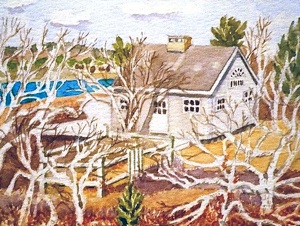
Upisland Camps
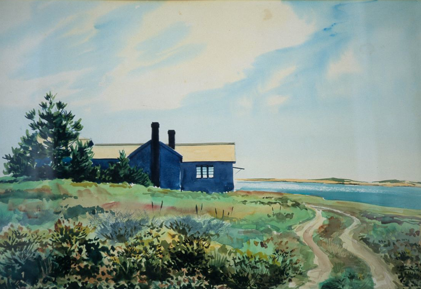
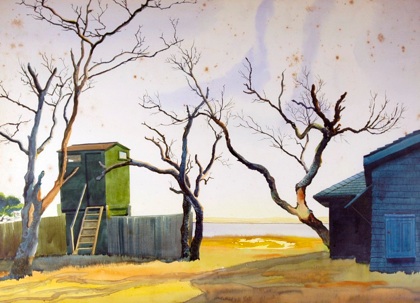
Painting by Sandy Low
Family members began to spread out from Harthaven in 1939. The Moores went to Middle Point on Tisbury Great Pond where many of them still own camps and winterized homes, as John Moore describes. “On October 24, 1939, Nanny (Martha Hart Moore) and Grampa Moore (Ethelbert Allen) bought Middle Point, a large peninsula of approximately 55 acres jutting into Tisbury Great Pond from an Ethel B. Strater. Included in the purchase was a hunting camp on the edge of the peninsula with gorgeous views over the pond to the west. The shack included a small tower where Grampa and his hunting cronies shared the duty of watching for approaching ducks and geese while the others remained in the shack itself, nice and warm over their card games. There was a wire running from the main cabin, ending with a battery powered bell. A simple push or two on the signal button was sufficient to send the hunters scurrying out to the duck blinds located along the edge of the pond. ...Eight of sixteen first cousins of my generation built small cottages at Middle Point.” John Moore: Harthaven - A Brief History
Painting by Sandy Low - now in Martha Moore collection
My father and Stan Hart (Sr.) had a hunting blind out near Deep bottom Cove for duck hunting (and they also got a few oysters while out there). They took part in Fall deer hunting - and competed in blue fish catching. Joanne Shepard
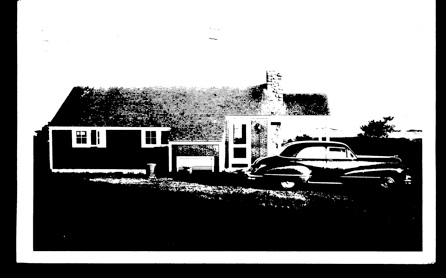
“Everyone referred to this as the 'Red Shack'. Owned by William Hart.” Lisa Hart.
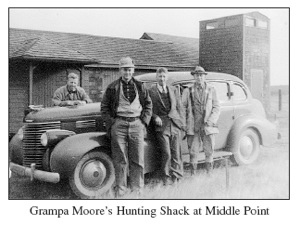
Martha’s Vineyard lies along the eastern migratory flyway. Accordingly, duck and geese hunting was very good during the fall hunting season. Until the mid-thirties, it was legal to use live decoys. Since hunting for Canada geese was more popular than for ducks, Grampa had a string of live, tame, mature geese secured alongside his blinds. He also kept a number of their young offspring penned there. When a flock of geese hove into view, the young decoys were released. They would fly up to the approaching flock until they realized they weren’t “family.” They would then “return to base,” trailing the new, unwary flock right in to the gunners’ trap. John Moore - Harthaven - A Brief History
E.A. Moore's Hunting Shack
Update: John Moore
Grampa Moore purchased a large peninsula known as Middle Point jutting out into Great Tisbury Pond in 1939 so he and his cronies could go there duck and geese hunting. There was a shack on the property where five men could sleep.
A wonderful benefit to the entire Moore family was the availability of oysters and clams along the shore near the shack.
After E.A.'s death in 1956, the property was divided up among his five children.
Mike Pease (or at least his two children) own the shack now while his neices and nephews own a house built immediately to the east by Martha "Patty" Pease. Charlie Rathbone and half-brother Lanny McDowell have sold their lots on the point, Roswell Moore sold his seven acres to brother Max, Ronnie Moore sold his lot and the lot containing the small cottage built by Allen Moore, Jr. now belongs to his son Allie. Max and Alice's children, Ben, Gay, Marty and Alexander have built cottages on their lots. Peggy Yoars still owns her lot
From John Moore: William H' Hart's oldest son, George, purchased 21 acres where the shack lies in 1926 from a Cornelius Lothrop. He also purchased another 20 acres or so on Upper Chilmark Pond just to the east of the shack property. George had approached Cornelius some time before about buying the land on the pond but it wasn't for sale. But in 1926, Cornelius' house had burned down and he supposedly hopped on his bike, rode down to Harthaven to find George to tell him he'd sell if he'd purchase his 70 acres between South and Middle Roads.
George gave his daughter Margaret the 21 acres of the shack property, the 20 or so acres to the east on the pond to son Don and the 70 acres to son Mervin. But Mervin divested all properties he owned and moved to California in the 1940s. Margaret bought his 70 acres. Margaret, in turn, turned her Chilmark properties over to her sons, Bill, Geof and Howard (Bung) Young. Bung and wife Hallie built their cottage, "Safari House," in 1971. Bill Young gifted his almost nine acres to his daughter Caroline and son Peter in 1979. Peter sold his lot but Caroline and I built our first house on our lot in 1981-'82.
The three brothers had the 70 acres surveyed and obtained approval of a subdivision of 30 two acre lots. Fortunately they never developed this subdivision. In 1983, Caroline and I suggested to Bill that they turn most of the 70 acres over for conservation. Geof and Bung agreed and ultimately 49 acres were turned over to the Conservation Commission for $304,000. Seven three acre lots were surveyed in the northeast area of the land and six of them have been sold. But Caroline and I retained Lot 7 and built a house there in 1995-96.
In 2000-'01, we built a guesthouse closer to the pond from our original house (which is now owned by our four children). At about the same time, Jean and Geof Young built "Grand View" close by the original shack.
Grampa’s Camp
Martha Moore
Sometimes we spent weekends at Grampa’s camp up island. Before we set off from Harthaven we bought food in Oak Bluffs and a huge block of ice that was loaded into the car by a man gripping curved metal tongs that looked like a torture tool. When we got to Deep Bottom Road, Pop lowered the tailgate for us to sit on. We dragged our bare feet over high grass that felt like coarse hair. Occasionally our heels hit a big rock and our legs shot upwards. We followed the old road that went by a pasture where a horse followed the car. We made Pop stop so we could pat it and it bit me once.
The first time I entered the camp there was an enormous buck head sticking out of the living room wall. Its eyes were still, brown and alive. I didn’t feel sorry for it but wondered why someone would put an animal on a wall – to what purpose? - and whether its hind end was on the other side of the wall. It wasn’t. Our 4 bunk beds filled that room and we had fights about who got to sleep in the upper bunks. Those of us in the lower ones pushed broom handles through the springs and into the mattresses of the upper bunks.
The ice cube was put into a wooden box attached to the north outer wall of the camp and there were shelves above to stack food on. In the kitchen was a hand pump that Pop primed at soon as we arrived. When he pumped for water we heard airy gasps with each downward thrust, then a gurgle that seemed to climb up the pipe and turn into water coming out at the lip. Mom cooked on a coal stove and we read or played cards under kerosene lamps that smelled funny and illuminated the living room in an amber glow.
Grampa had a large 4-oarlock rowboat, white with blue trim, which was so heavy we never dragged it out of the boathouse on the east side of the camp. Instead we used a canoe. Wind always made it a struggle to paddle the canoe to the south shore. More often we wound up dragging, cursing and beaching it and walked instead, passing half buried rusty dummy bombs, some of which Ben brought home. The big waves were unmanageable, wild and thrilling, and we ran away from them as they washed ashore. Our fat black pug, Minnie, liked to chase gulls but always looked as if she were running in place, as hard as she could, never gaining on a bird.
Attached to the camp was a tower from which Grampa and his duck hunting friends scouted for ducks in the fall. We loved climbing steep stairs to the tower door and looking out the small horizontal windows to the Great Pond. There were always dead flies piled on the window sills and the room smelled musty.
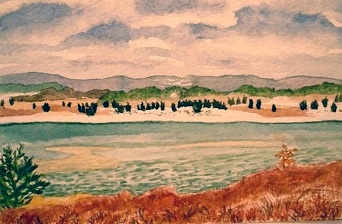
Martha Moore (left) Middlepoint and (right) Sandy’s Camp Tisbury Great Pond
